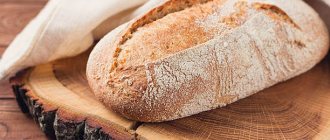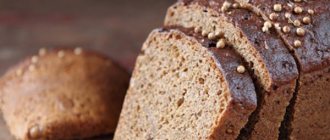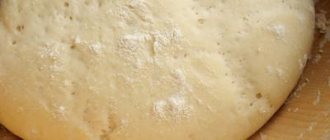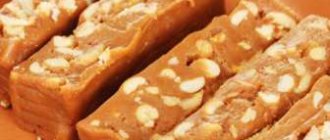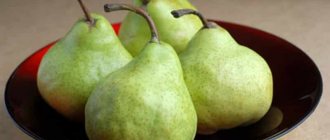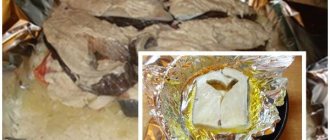The basis of a healthy lifestyle is the consumption of foods in the diet that are enriched with vitamins and minerals and do not contain high-calorie carbohydrates, difficult-to-digest compounds, harmful dyes and additives. It is recommended to consume flour products in small quantities or not at all if a person is on a diet. Manufacturers of some types of bread, including malt bread, assure that this bread is not only possible, but also necessary to be consumed for a healthy lifestyle.
Malt value
Malt is widely recognized as one of the most useful, however, the first step is to find out what it is. It itself is a product obtained by artificially sprouting cereal crops such as wheat, barley or rye. As production progresses, diastase, which is a special enzyme, begins to accumulate in the grains themselves. With its help, foods that contain starch begin to break down into simple sugars. During their interaction with yeast, alcohol begins to be produced.
In order to obtain malt, you must first go through two stages - preparation for germination, and then the germination itself. Ultimately, an extract is obtained for baking needs, which is added during kneading. It is the main ingredient in malt bread, it enhances fermentation, improves the elasticity of the dough and absorbs excess water.
Due to its valuable composition, malt has a positive effect on the human body. In addition, it contains a large amount of protein and amino acids, which stimulate muscle development. The product also has a beneficial effect on the gastrointestinal tract, especially for barley malt, which is rich in fiber. Its frequent use helps cleanse the body of harmful toxins and waste.
Rye malt also has its own beneficial qualities - it is recommended to use it for anemia and exhaustion, as it has a restorative effect and has a high energy value. And finally, malt is recognized as one of the diabetic products - the beneficial substances it contains normalize blood sugar levels and slow down the absorption of carbohydrates.
What is whole grain flour
This type of flour is produced from grains of various crops, which are obtained by grinding without removing the outer shell. Various types of cereals can be used in the manufacturing process: wheat, barley, rye, buckwheat, oats and others.
Whole grain flour also differs in the method of grinding: usually semolina (fine grinding) and wallpaper flour (coarse grinding) are distinguished. Whole grain flour is especially common among people who adhere to a healthy lifestyle. This is explained by the large proportion of useful substances in the grains. Among them are vitamins (in particular B and E), proteins, fiber, and minerals.
What is malt bread?

To understand the benefits and harms of malt bread, the first step is to understand what it itself is. As a rule, flour is used to prepare a regular wheat product. And this variety is no different from others, since the recipe also contains a mixture of wheat and rye flour. However, in addition to this, the composition contains malt, which is pre-sprouted grains of wheat or rye cereals. The presence of this ingredient not only increases the beneficial properties of the product, but also significantly affects the taste. It will be very easy to find the product on the counter, since its crust has a rich dark hue, and the bread itself tastes very piquant and has a characteristic strong aroma. It is worth noting that bakers quite often add additional ingredients to such bread (to improve the taste) such as raisins, coriander, caraway seeds or nuts.
Whole grain bread recipes
The best breads are those made independently, from proven ingredients. Only in this way can you create the most useful product.
Without yeast
Ingredients:
- whole grain flour (0.2 kg);
- oat flakes (0.2 kg);
- peeled sunflower seeds (0.1 kg);
- salt (0.5 tsp);
- flax and sesame seeds (50 g);
- sugar or natural honey (1 tsp);
- vegetable oil (1 tbsp);
- distilled water (0.7 l).
Pour flour, oatmeal, all the indicated seeds, as well as salt and sugar (or honey) into one container. Add water, stir and leave for a maximum of 15 minutes. Line a baking tray with paper and grease with oil. Spread the thickened mass evenly over the entire area to form a thin layer. Cut the dough into pieces, sprinkle with seeds and place in the oven for 40 minutes at 170°C. After this, you need to reduce the temperature to 160 ° C and keep the bread for another 20 minutes.
In the oven
Ingredients:
- whole grain flour (0.15 kg);
- rye flour (50 g);
- yeast (1 tsp);
- water (0.15 kg);
- sugar (up to 2 tsp);
- salt (pinch);
- vegetable oil (up to 2 tbsp);
- sesame, flax seeds.
Place a mixture of flour (both types), sugar and salt in a bowl, and add yeast. Pour in water and sprinkle the mixture with sesame seeds. The dough is mixed with oiled hands. Roll out the cake (no more than a centimeter thick), grease with oil and continue stirring, then leave for half an hour. Roll out the dough again and outline the contours of the loaves. The flatbread is placed in the oven for a quarter of an hour at 200°C.
Rye
Ingredients:
- rye flour (0.5 kg);
- warm water (0.45 l);
- yeast (5 g);
- rye malt (1 tsp);
- honey (1 tsp);
- salt (2 tsp);
- caraway.
In a bowl, alternately add heated water (half of the indicated volume), yeast and a spoonful of honey, and then leave the mixture for a quarter of an hour. Boil the remaining water and mix with malt. The bowl with yeast must be replenished with flour and salt, and then pour the mixture with chilled malt. Make the dough and leave it for 2 hours. Then divide the mass into balls of equal size and make thick cakes out of them. Place them on a baking sheet, sprinkle with cumin and lightly pierce with a fork. When the cakes are round, they are sent to the oven for 20 minutes at 240°C.
Wheat
Ingredients:
- wheat flour (0.45 kg);
- rye flour (50 g);
- yeast (2.5 tsp);
- distilled water (0.3 l);
- milk powder (2 tbsp);
- butter (2 tbsp);
- salt (1.5 tsp);
- honey (1 tbsp).
In one bowl mix flour (both types), salt, yeast, milk powder. Separately, you need to combine honey and oil with water, and then pour it into the flour. Knead the dough and leave for two hours. Divide the mixture into equal parts and make small bars. When they are round, place them in the oven for half an hour at 180°C.
Sugarless
Ingredients:
- oat flour (30 g);
- flaxseed flour (40 g);
- apple (120 g);
- water (0.15 l);
- two chicken eggs;
- salt (quarter tsp);
- cinnamon (1 tsp).
Beat one full egg and one white until foamy. Add oatmeal, sprinkle with cinnamon and grated apple. Mix the ingredients, add flaxseed flour and knead the dough, pouring water into it. Place in a thin layer on a baking sheet and bake for 20 minutes at 170°C.
The benefits of bread
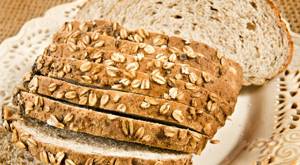
To understand the benefits of malt bread, you should pay attention to the value of the main ingredient. It lies precisely in the fact that the product has a unique chemical composition, which is filled with a huge variety of substances beneficial to humans, necessary for normal life. Sprouted grains themselves are incredibly healthy, so many nutritionists really recommend introducing this type of bread into a standard diet, because thanks to its composition it brings noticeable benefits to the body. Nowadays, malt bread is considered a medicinal variety, since the raw materials used for it contain a large number of valuable amino acids and monosaccharides.
Doctors recommend eating malt bread for diabetes. It is also useful for patients who have undergone surgery and need recovery. After all, it contains useful substances that are necessary for rehabilitation.
Chemical composition of malt bread based on rye flour
| Nutritional value of the product (per 100 grams) | |
| Calorie content | 258 kcal |
| Squirrels | 8.5 g |
| Fats | 3.3 g |
| Carbohydrates | 45.2 g |
| Alimentary fiber | 5.8 g |
| Cholesterol | 0 g |
| Ash | 2.5 g |
| Water | 37.3 g |
| Vitamin composition (in milligrams per 100 grams) | |
| Tocopherol (E) | 0,33 |
| Phylloquinone (K) | 0,0012 |
| Ascorbic acid (C) | 0,4 |
| Thiamine (B1) | 0,43 |
| Riboflavin (B2) | 0,34 |
| Choline (B4) | 14,6 |
| Pantothenic acid (B5) | 0,44 |
| Pyridoxine (B6) | 0,08 |
| Folic acid (B9) | 0,11 |
| Nicotinic acid (PP) | 0,15 |
| Nutrient composition (in milligrams per 100 grams) | |
| Macronutrients | |
| Potassium (K) | 166 |
| Calcium (Ca) | 73 |
| Magnesium (Mg) | 40 |
| Sodium (Na) | 660 |
| Phosphorus (P) | 125 |
| Microelements | |
| Iron (Fe) | 2,83 |
| Manganese (Mn) | 0,82 |
| Copper (Cu) | 0,19 |
| Selenium (Se) | 0,309 |
| Fluorine (F) | 0,51 |
| Zinc (Zn) | 1,14 |
Ingredients used
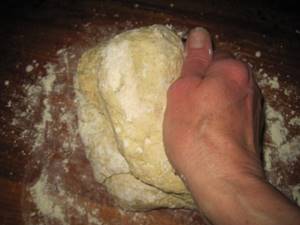
To talk about the benefits and harms of malt bread, you need to know exactly how it is prepared and what the ingredients are. It is worth noting that the ratio of the types of flour used depends entirely on the manufacturer’s recipe, as well as on the production technology he has chosen.
In particular, such bread can be prepared even at home, so the ratios may vary. In addition to flour, the manufacturer must also pay attention to the baking powder used - mainly sourdough or liquid yeast plays its role.
And of course, special attention should be paid to the most important ingredient - malt. Now barley is most often used, although it can be replaced with wheat, rye or corn. Depending on the type used, the structure and taste of baked bread may vary slightly. Dark malts are also natural colorants, so their use gives the product an attractive brown crust and a slightly sweet flavor.
Properties of bread
Calorie content of whole grain bread
Wholemeal bread has few calories, but the amount increases dramatically when other foods are added. 100 grams of whole grain bread contains from 200 to 400 calories. This indicator largely depends on the type of flour, as well as cereals and additives.
Glycemic index of whole grain breads
Crispbread is a product with a medium glycemic index. The GI index may vary depending on the composition and production technology, but, as a rule, does not exceed 45.
What are the benefits of whole grain bread?
Whole grain breads have properties that are useful in the fight against obesity and diabetes, relieve symptoms of intestinal weakness, diseases associated with blood vessels and heart function. Consumption of these products helps prevent vitamin deficiency and depression, and the enzymes and antioxidants in the bread help reduce the likelihood of premature death by 20%.
In this case, the most useful option is called extruded bread, that is, those in the manufacturing process of which high pressure was applied to the soaked cereals. Extruded whole grain breads resemble briquettes and are often round in shape. In the structure of each individual specimen, full-fledged grains are visible.
Whole grain bread - a product for weight loss
Many dietary menu options involve the complete exclusion of bread from the diet. In such cases, whole grain breads, which are valued not only for their low calorie content, but also for the abundance of nutrients in their composition, become an excellent replacement.
Fiber brings great benefits in the process of losing weight. Its ability to cleanse the digestive tract of toxins and speed up the metabolic process is especially appreciated by people on a diet. In addition, foods high in fiber fill the body more easily and keep you feeling full for a long time.
The rigid structure of the bread itself plays a big role. This promotes thorough chewing, activation of the jaw muscles and slow passage of food into the stomach. As a result, food and its beneficial components are better absorbed, and satiety comes faster.
Is there any harm in eating whole grain bread?
Whole grain breads are low in calories compared to regular bread, so they can be beneficial if eaten in moderation. However, often the low calorie content of a product only relaxes you and makes you eat more than usual. In such situations, even more calories are consumed than with regular bread.
When choosing bread rolls, it is important to pay attention to their production method. Products produced by baking are similar in properties and nutritional value to an ordinary loaf of white bread. High temperatures during cooking contribute to the loss of some beneficial ingredients.
It is worth excluding or limiting the amount of this product in the diet of people suffering from gastritis, severe obesity and cholecystitis. Also, people with gluten intolerance should not eat the bread due to the presence of this substance in the composition.
Healthy dietary product
GOST
As you know, a special GOST has been established for all rye-wheat products in Russia. Malt bread also has it - this is GOST 52961-2008. It defines the requirements that must be met by manufacturers of all flour malt products. In addition, in this document you can find out the terms and definitions that are used for production, as well as the classification and standards of the raw materials included, characteristics of packaging, production and even labeling of the finished product.
For example, according to GOST, this bread must contain various types of malt, which will enrich the product with beta-carotene, fiber, minerals and vitamins, which will make it not only tasty, but also extremely beneficial for the health of the body.
What is malt
These are soaked and sprouted cereal seeds. Most often, barley seeds are used, less often - wheat, corn, rye or triticale (a hybrid of rye and wheat). When grains germinate, the fermentation process starts, which is artificially inhibited at the final stages of production. The seeds are dried, doused with hot air vapor, and then added to the dough.
Content:
- What is malt
- Useful properties of the ingredient
- Chemical composition of malt bread based on rye flour
- What is gluten and is it found in malt bread?
- How to choose the right bread
Multifunctional malt is used not only for making bread, but also alcoholic/non-alcoholic drinks such as kvass, beer, kulaga, whiskey, and maxyma.
How is malt obtained?
The process of obtaining the ingredient consists of two stages: soaking and germination. Soaking is a preparatory stage. Only from swollen and pre-prepared grain can cereal sprout. During germination, special chemical changes in the composition of the grain are triggered.
For high-quality growth and development, grains need constant access to oxygen. As soon as the germination process starts inside the seeds, oxygen consumption increases several times. An increase in oxygen consumption leads to a decrease in the concentration of dry matter: starch (contained in grain) is converted into a solution of glucose, sucrose, maltose and other soluble carbohydrates. The dissolution process also affects the cell walls. Carbohydrates and fatty oils gradually begin to oxidize, and proteins turn into large protein enzymes.

After all the transformations, the development of leaves and, after some time, of an adult plant begins.
Until the 19th century, sprouted malt, in which the leaves had not yet sprouted, was used for food. After this time point, it was discovered that high-quality sprouted long malt retains a high concentration of beneficial nutrients.
Malt germinates only under two basic conditions: plenty of oxygen and minimal exposure to ultraviolet radiation.
Features of using the component
Malt was primarily used to produce beer, wine and other alcoholic or non-alcoholic drinks. For example, in beer, malt is used in its pure form, while in wine it is necessary to dissolve and saccharify starch from other ingredients of the drink. In all cases, the product acts on the same principle: it loses its own starch or that obtained from other food products, then the liquid undergoes fermentation.
The component is used to make malt extract - thickened or evaporated wort (sweet nectar). The drink is prepared from crushed grains of corn, rye, barley, wheat and all possible cereals. Most often, the wort is evaporated at a temperature of 45 to 60°C. For preparation, a gentle vacuum manufacturing method is used. After a series of simple manipulations, the drink is brought to the consistency of thick syrup, then clarified and removed from unpleasant astringent compounds (separated or using a centrifuge). The wort is used in the gastronomic industry. Nectar is used to prepare pasta, bakery products, confectionery products, kvass, beer and even medications.
Malt is also used in the food industry. It is added to all baked goods, regardless of flavor and type of flour: buns, pita bread, baguettes, various types of bread, sweet flour dishes. The component increases the overall calorie content of the finished product, enriches it with an abundance of vitamins, micro- and macroelements.
Energy value

Now a little about the calorie content of malt bread. The standard nutritional value of the product is 236 Kcal, which is a fairly high figure. It contains a fairly large amount of complex carbohydrates - they account for as much as 202 Kcal, proteins - 30 Kcal, and fats - only 6 Kcal. In general, malt bread is recognized by nutritionists as a balanced product that is beneficial for the human body, but consuming it in large quantities is still not recommended, especially if you are overweight.
Product Overview
Whole grain crispbread with cranberries Sattvik
The product contains dietary fiber, a number of vitamins, and protein. No yeast or flour is used in the manufacturing process. Calorie content is 305 kcal. Crispbread has a positive effect on the gastrointestinal tract, improves blood composition and promotes accelerated metabolism.
Sattvik
Russian health. Whole grain flax bread Chocolate
Contains flaxseeds and dark chocolate. Eating bread helps to reduce body weight, normalize the functioning of the circulatory system, improve mood and cleanse the body. 100 g of product brings about 430 kcal.
Russian health
Whole grain bread without additives Eco-Bread
Contains 212 kcal, suitable for replacing bread during a diet. The product contains exclusively sprouted grains and salt, which contain a number of useful minerals and affect the functioning of the digestive system.
Eco Bread
Finn Crisp Original Rye. Rye bread
Contains whole grain flour, as well as water, salt and yeast. The crispbreads are made in such a way that all nutrients (vitamins, fiber, minerals) remain in maximum quantities. The calorie content of 100 g of product is about 350 kcal.
Finn Crisp Original
Finn Crisp Traditional. Traditional bread
The product is recommended for people on a diet and leading an active lifestyle. There are no flavorings, monosodium glutamate or preservatives. Contains up to 71% whole grain rye flour, yeast and water. Calorie content - 360 kcal for 100 g.
Finn Crisp Traditional
Dr. Korner. Corn and rice crispbread with Provençal herbs
The breads are gluten-free and made from corn flour and spices. There are 300 kcal per 100 g of product (15 kcal per loaf), so it is suitable for weight loss. Dietary fiber helps improve the functioning of the gastrointestinal tract and remove toxins from the body.
Dr Corner
Harm of bread with malt
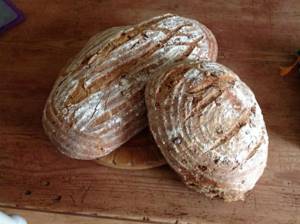
When researching the benefits and harms of malt bread, don't focus only on the benefits, as it may also be harmful for some people. Yes, it really does contain a number of valuable substances, which is why nutritionists recommend its use for people of all ages who care about their health. But at the same time, this bread should under no circumstances be eaten by people who suffer from cholecystitis or chronic pancreatitis, or suffer from gastritis. The whole point here is that malt bread has quite a strong acidity, which can harm the gastrointestinal tract of people with similar diseases.
How to choose the right bread
The benefits of a bakery product directly depend on its composition and processing method. High-quality bread saturates the body with so-called complex carbohydrates, which promote metabolic/energy processes and support human life.
Supplements
Malt bread can be called a healthy food product in absentia, because it contains malt seeds. Why are they good:
- increase the overall calorie content of the dish;
- saturate the body with vitamins and nutrients;
- have a positive effect on taste;
- help to absorb other foods faster and better.
Ideal if the composition contains not only sprouted grains, but also seeds, dried fruits or nuts. The only drawback of this bread is the minimum shelf life. After the expiration date, the bread becomes harder than granite, which is impossible to chew or remove from the package.
Flour quality
The name of the flour can play a cruel joke on the consumer. Let's simulate a situation: in front of you are two loaves of bread. On one of them there is the inscription “high-grade flour”, on the second - “second-grade flour”. The choice of a gullible consumer will instinctively fall on the first loaf of bread. “Top grade” seems to us to be a guarantee of quality, safety and health, but that’s the trick. Premium flour is an empty product that lacks a nutrient composition and belongs to the category of harmful “fast carbohydrates.” Second grade flour is processed to a lesser extent. The grain is cleaned only superficially, leaving the shell - the element in which vitamins and minerals are stored. Whole grain flour that has been coarsely milled is considered a “heavy carbohydrate.” Bread from it will not add extra centimeters to your waist, but will contribute to a high degree of activity throughout the day.
Best materials of the month
- Coronaviruses: SARS-CoV-2 (COVID-19)
- Antibiotics for the prevention and treatment of COVID-19: how effective are they?
- The most common "office" diseases
- Does vodka kill coronavirus?
- How to stay alive on our roads?
Forever give up regular white bread in favor of malt, rye, bread with bran and sprouted grains.
It is also necessary to take into account the peculiarity and concentration of flour. For example, rye flour is much more efficiently absorbed by the human body, provides long-term saturation, and contains a larger set of nutrients and fiber than wheat flour. It is best to eat “black” bread, in which the proportion of rye and wheat flour is 1:3 in favor of rye.
